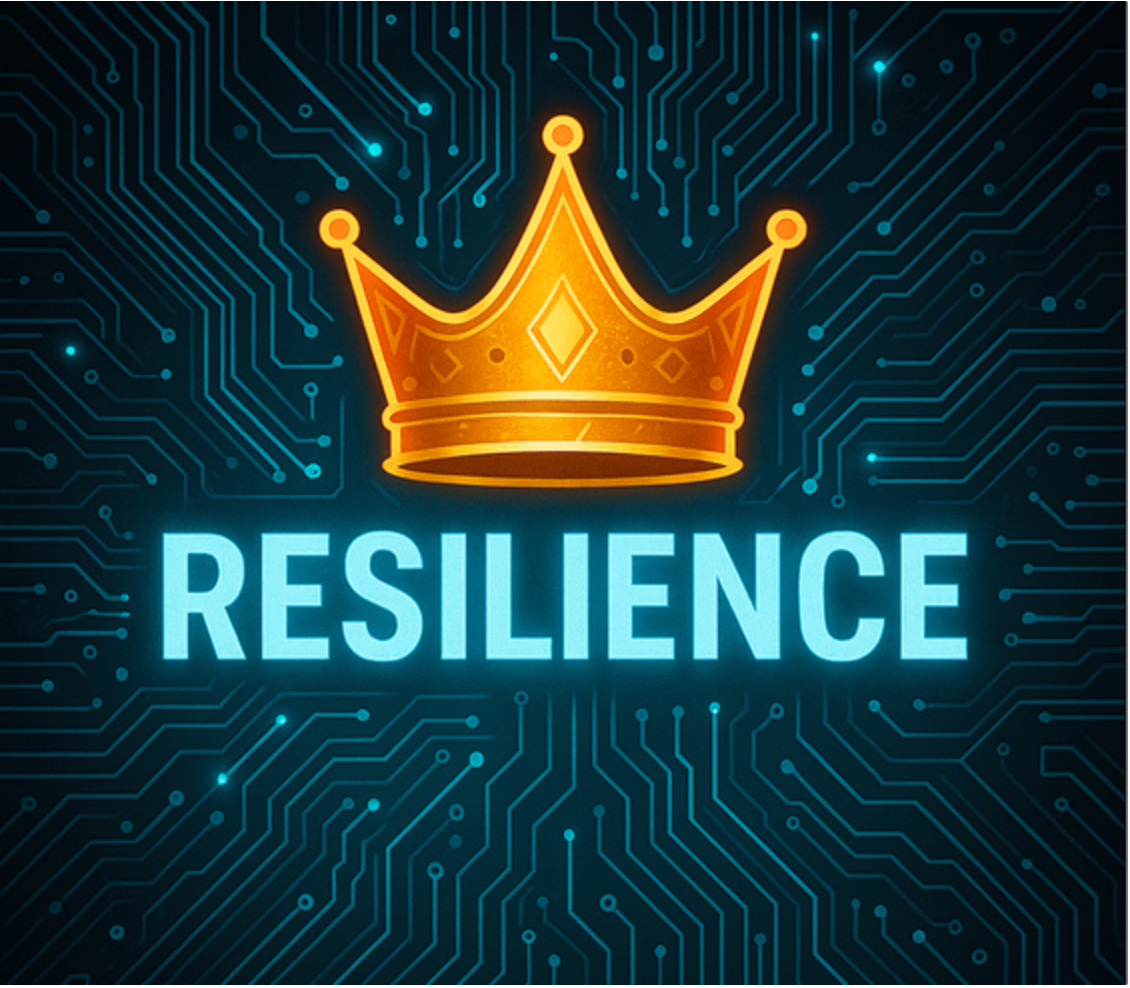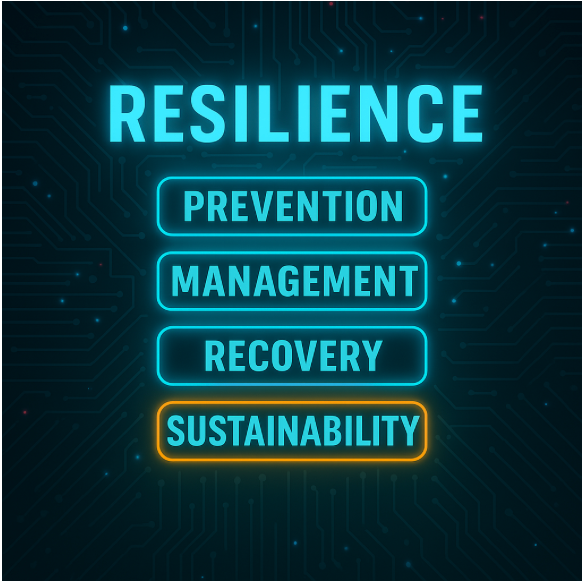Resilience is King
Have you checked your Cyber security resilience capabilities?
If your organisation suffered a cyber-attack how quick could it recover? Has your organisation set a targeted time for recovery?
- 74% of large businesses,
- 67% of small businesses and
- Overall, 4 in 10 businesses in the UK experienced a cyber security breach or attack in the last 12 months. (Source UK Government Cyber security breaches survey 2025).
When it comes to cybersecurity ‘Resilience is King’ - having a cyber security strategy supported by plans, targets and tools which provide your organisation with the right resilience capabilities e.g.
- The resilience to prevent an attack.
- The resilience to manage your organisation in the midst of an attack.
- The resilience to recover.
- The resilience to remain in business i.e. be sustainable.

Cyber security strategy, plans, targets, and tools?
When resilience is woven into your strategy and planning processes then cyber security truly does become part of the DNA of your organisation - think cyber security with all major plans.
Adopting a ‘secure by design’ approach also pays dividends as it becomes part of your normal service/product development, processes, protocols, and behaviours adopted, creating resilience as your organisation evolves.
Budgeting for cybersecurity operations and tools to assist the smooth running of your organisation is expected but not all organisations have budget set aside for any ‘unexpected’ cyber security issues. Having a cybersecurity business continuity budget as a contingency is good practice.
We have seen in recent times how organisations small to large have been caught unawares from a cyber-attack and without effective recovery plans and budgets. The cost of recovery from a cyber-attack can be colossal. Often organisations who experience a cyber-attack admit they ‘thought’ they had a good business continuity plan until a cyber-attack happens however, they did not foresee the true operational impact or indeed the costs involved to recover.
Setting the right measures and targets for monitoring your progress and cybersecurity performance should cover all aspects of your cybersecurity processes and policies.
Having the right cybersecurity digital capabilities in place is important with platform, systems, and people trained who know how to maximise their usage; working in unison they help you to be more resilient to a cyber-attack.
Do you have visibility of, or trust in, your organisation’s cyber strategy, plans, targets, and tools?
Resilience Capabilities
Being resilient to a cyber-attack is not just about preventing your organisation from attack, cyber resilience capabilities cover a number of aspects:
- Prevention
- Management
- Recovery
- Sustainability
Prevention
Scanning your organisation 24x7x365 for cyber threats across your entire potential attack surface e.g. networks, systems, perimeter, end point and application security enables your organisation to detect and prevent potential threats. Good cybersecurity partners with the latest digital cyber security tools also have the capability of using honeypot traps and the dark web to surface issues before they arise from potential threat actors.
Management
The human element of cyber security such as the people you employ both internally and externally are a crucial capability when trained and skilled to manage and orchestrate your overall cybersecurity landscape.
Having platforms and systems which you can rely upon 24x7x365 to enable for example authentication, encryption, malware protection, network security and continuous event and threat management; these are essential parts of your organisation’s operational armoury in managing the fight against cyber-crime.

Working in tandem with your digital capabilities including the use of AI, the human management and interpretation of information provides you with the best combination of threat detection, prevention, and management of your organisation’s cyber resilience.
Recovery
If your organisation has a cybersecurity attack you would like to think it is well prepared; however not all organisations review their disaster recovery or business continuity plans regularly enough to thoroughly review their cyber risk. Table top cyber exercises, penetration testing and overall business continuity plans, help together with robust platforms and systems.
Every second counts if your organisation is attacked, so ensuring you have the right expert partners, tools and capabilities is key to enabling the recovery of your data and in responding appropriately to a ransomware attack.
Your platform, systems need to have a robust storage, back-up and recovery system which leverages cloud computing and artificial intelligence technologies. This includes data integrity with immutability, air gapping and the ability to recover data anywhere and move it freely in accordance with your organisation’s plans.
Does your organisation have recovery time objectives? That is the amount of time an application, system or process can be down before the organisation is significantly harmed/damaged. Measuring, monitoring, and controlling your recovery with the right system partners enables your team to mitigate the risks more confidently.
Sustainability
The acid test of resilience is sustainability i.e. can your organisation function fully and survive if you have a cyber-attack?
A cyber-attack can be costly not only in the recovery of data and getting your operations up and running, but it can also be heavily brand affecting, haemorrhaging customers if they lose confidence and trust in your business.
In 2025, the average cost of a data breach has gone up 10% to $4.8M with some sectors costing more e.g. healthcare averaging $9.7M per breach. The average recovery time it takes is 258 days [Source: Cyber Security News].
If your organisation is attacked it is key to contain the incident impact and hopefully then eradicate the cyber issues and recover.
Learning from a cyber incident is often one of the most significant parts of incident response and is often ignored. The aim of the learning is to prevent this happening again and assess if for example you have the right cyber security support. For example, having partners and systems who you can trust in their capabilities and give you the confidence of recovery in case of a future of a cyberattack.
Unfortunately, there are organisations where a cyberattack does irreversible damage to their business-critical operations and renders their business no longer sustainable.
In Summary
Having a good combination of a strong cyber team who can use good cyber security digital systems and tools lays the groundwork for your business to be cyber resilient.
Of course, staying alive to the latest cyber threats and technology developments is necessary. How you then approach your level of investment and resourcing to size and scale your cyber resilience capabilities appropriately for your organisation can be more difficult. That is where we come in – at the Human Digital collaborative. We can collaborate with your organisation to understand and enhance where required your cyber resilience capabilities.

At the Human Digital Collaborative, we want you to be cyber-secure.
We can offer through our Business Consultancy, cyber experts who can understand your needs and see where we can help in your cyber journey. Do reach out to us – the Human Digital Collaborative.com







